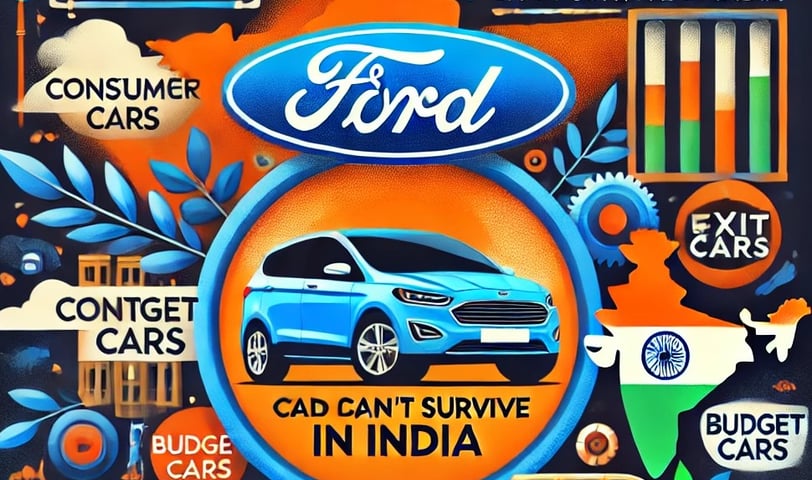Why Ford Motors Couldn’t Survive in India
I still remember the day my cousin proudly brought home his new Ford EcoSport. It was a sleek, powerful SUV that instantly turned heads in our neighborhood. I was in awe. But only a few years later, he was complaining about expensive servicing and the lack of nearby service centers. And then came the shocking news: Ford was exiting India. It made me wonder—how could a global giant like Ford fail in a market as massive and promising as India? In this blog, I’ll explore this question, drawing from personal observations, market trends, and some lessons that all of us, even as students, can learn.
Laksh Rathore
12/2/20243 min read


Why Ford Motors Couldn’t Survive in India
Introduction
I still remember the day my cousin proudly brought home his new Ford EcoSport. It was a sleek, powerful SUV that instantly turned heads in our neighborhood. I was in awe. But only a few years later, he was complaining about expensive servicing and the lack of nearby service centers. And then came the shocking news: Ford was exiting India. It made me wonder—how could a global giant like Ford fail in a market as massive and promising as India? In this blog, I’ll explore this question, drawing from personal observations, market trends, and some lessons that all of us, even as students, can learn.
1. The Price Factor: A Penny Saved Is a Penny Earned
Growing up in India, I’ve seen how much value we place on affordability. My family’s first car was a small hatchback from Maruti Suzuki—the go-to brand for middle-class households. Why? It was affordable, reliable, and came with cheap maintenance. Ford, on the other hand, positioned itself as a premium brand with slightly higher price tags.
For instance, the Ford Fiesta and Ford Aspire were priced higher than comparable models from Hyundai and Maruti. According to a 2019 study by JATO Dynamics, price-sensitive Indian buyers preferred brands offering more features at lower costs. Maruti Suzuki and Hyundai captured over 65% of the market, while Ford struggled with just 2%. In my opinion, Ford failed to understand that in India, we’re not just buying a car—we’re buying long-term peace of mind.
2. The Service Gap: Out of Sight, Out of Mind
One summer, during a road trip to Himachal Pradesh, our car broke down. Thankfully, it was a Maruti, and within minutes, we found a nearby service center. Imagine being in that situation with a Ford car. With fewer service centers and higher maintenance costs, Ford owners often felt stranded—both literally and figuratively.
Data from Statista (2020) shows that Maruti had over 4,000 service centers in India, while Ford lagged far behind with fewer than 500. For Indian consumers, convenience matters as much as the product itself. What I’ve learned is that selling a car is only half the job; providing after-sales support is what keeps customers loyal.
3. The "Desi" Connection: Know Your Audience
In India, car ownership isn’t just about functionality—it’s deeply emotional. Families discuss, debate, and even pray before buying a car. It’s a milestone. I’ve noticed that brands like Tata and Mahindra excel because they tap into this emotional connection. Their advertisements resonate with Indian culture and values. Ford’s marketing, on the other hand, often felt too "global" and disconnected from local sensibilities.
Take the example of Ford’s Figo. Despite being a decent car, it struggled to compete with Hyundai’s i20, partly because Hyundai’s campaigns emphasized affordability, family, and trust—concepts that resonate deeply with Indian buyers. Ford, by contrast, marketed its cars as aspirational and premium, a strategy better suited for developed markets.
4. Timing Is Everything
Ford entered India in the mid-1990s, around the same time as Hyundai. While Hyundai adapted quickly—launching the Santro, a compact car perfect for Indian families—Ford initially focused on larger, fuel-hungry sedans like the Ford Escort. By the time Ford introduced more affordable models, Hyundai and Maruti had already cemented their positions as market leaders.
According to a 2021 report by The Economic Times, Ford’s market share dwindled over the years because it was always playing catch-up. What I’ve realized is that being first isn’t as important as being relevant. Ford missed the opportunity to lead with products tailored to Indian needs.
5. The Policy Puzzle
India’s complex tax structure also played a role in Ford’s struggles. Cars longer than four meters attract higher taxes, making compact cars more viable. While Hyundai and Maruti mastered the art of designing under-4-meter cars, Ford’s portfolio largely consisted of larger vehicles. The result? Higher prices and lower sales.
Moreover, India’s shift toward electric vehicles (EVs) caught Ford unprepared. While Tata Motors launched its Nexon EV to much acclaim, Ford had no comparable offerings. In my opinion, staying ahead of policy and technology trends is crucial, especially in a dynamic market like India.
Conclusion: Lessons for Life and Business
Ford’s exit from India is more than just a business story; it’s a lesson in adaptability, empathy, and timing. As a law student, I’ve learned that understanding your audience—whether it’s a judge, a jury, or a car buyer—is key to success. Ford couldn’t connect with the Indian consumer’s heart and wallet, and that’s why it lost out.
For readers who are aspiring entrepreneurs or just curious minds, my takeaway is simple: No matter how big you are, you can’t succeed in a new environment without understanding its unique needs and challenges. As for me, every time I see a Ford car on the road now, I feel a tinge of nostalgia and a reminder to always keep learning and adapting.
